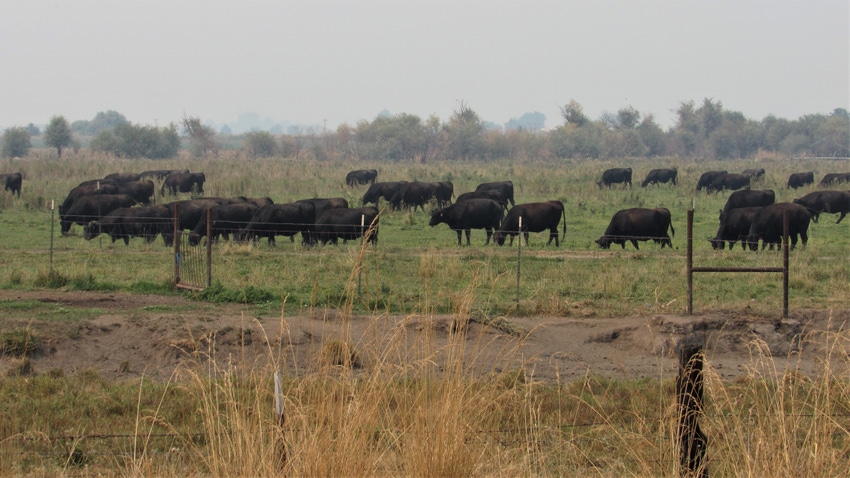September 17, 2020

Once cattle are moved out of the path of wildfires, that may not be the end of worries about their welfare, which is why their status should be assessed daily, a team of scientists advises.
Exposure to extreme heat or wildfire smoke can result in long-term health complications, including problems with lungs, feet, udders and teats, skin and eyes, according to an essay from the School of Veterinary Medicine at the University of California, Davis.
“Animals may stop eating after a few days to weeks when their status starts to deteriorate,” write authors Theresa Becchetti, Sheila Barry and Gaby Maier. Their essay is based on academic papers by UC Davis’ John Madigan, David Wilson and Carolyn Stull and South Dakota State University veterinarian Russ Daly.
Here are some things that ranchers should be aware of, according to the scientists.
Lungs
The impacts of smoke inhalation can be long-term as well as immediate. Check for facial or muzzle burns or even a crusty nose as signs of an animal who likely suffered smoke inhalation. Here’s what to expect, according to the essay.
1-24 hours: Pulmonary edema. Fluid builds up in the alveoli (air exchange areas deep in the lungs) due to the irritant effect of smoke. Rapid, moist breathing and coughing will result. You may see some frothing at the nose.
Several hours to several days: The small airways deep in the lungs swell up, making it harder for air to pass through to the alveoli, where the oxygen exchange happens. Heavy, labored breathing and wheezing is a result as air whistles through the partially blocked airways.
4-10 days later: Healing of the airways is as complete as it will get. Until this time, cattle may be more prone to shortness of breath and acute respiratory collapse if they are excited or stressed. Take care when working cattle to reduce stress the few months following the fire or whenever smoke is visible. Ideally, do not attempt to handle or move the cattle for 4 to 6 weeks post-fire or after air quality is back to normal.
Months to years: Some survivors may be intolerant of exercise or heat due to longer-term damage to small airways. Good records will help you identify animals who have survived a fire and help make informed culling decisions. Consult a veterinarian to develop a treatment strategy, which could include the use of antibiotics to ward of pneumonia as well as anti-inflammatories. Provide plenty of fresh water and limit dust exposure.
Feet
The most common result of severe heat damage is the sloughing of hooves 1 to 3 weeks after the fire. They may appear normal and healthy, but then there is a sudden onset of lameness, with signs of infection around the coronary band. While this can be confused with infection or foot rot, it usually means that hooves are in the process of sloughing, and antibiotic treatment will not be helpful. With few exceptions, these animals should be euthanized. Ideally, animals that have come through the fire should be provided soft bedding if possible.
Udders and teats
The cow's udder and teats are more susceptible to burns, not having a protective hide around them. Check them for signs of burns and inflammation, which can result in mastitis and non-productive quarters. Consider culling any cows with udder issues, especially assessing the health of the teat openings.
Skin burns
Burn wounds in cattle should be examined by a veterinarian; severely burned animals may need to be put down. Minor burns may be treated with topical (surface) treatments along with systemic antibiotics to minimize wound infection. A source for burn wounds around the head and neck area is the melting of plastic ear tags during conditions of high heat. Protect wounds from fly strike with insect repellents.
Calves
If calves survive the fire and smoke inhalation, they may not be able to nurse if their dam has burned, inflamed teats or mastitis. Make sure each calf is paired back up and can successfully nurse. Calves unable to nurse will have a much slower growth rate and could develop additional health issues.
Bulls
The extent of burn damage to the sheaths and scrotums may not be evident for 4 to 6 weeks. As healing progresses, sheaths should be examined for scarring that may block the opening. Prioritize breeding soundness exams before the breeding season for bulls that are being retained. In some locations, trichomoniasis may be an issue when herds are commingled during the fire. Consult your veterinarian.
Eyes
Eyes irritated due to smoke and heat may show signs similar to pinkeye. Healing of these conditions will likely take longer than a typical pinkeye case, and in some cases, permanent blindness may result. Consult your vet about possible antibiotic treatment, being aware of any withdrawal times.
“While a great number of surviving cattle will not show any long-term effects of a wildfire, cattle producers should be aware of the potential problems down the road,” the authors advise. “Producers should always consult a local vet for help making treatment and culling decisions in the best interest of the animal and the operation.”
About the Author(s)
You May Also Like






